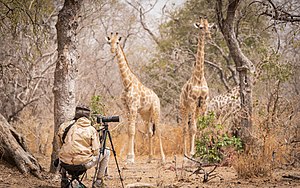
Wildlife refers to animal species that are not considered to be domesticated, farm, companion or working animals. They are the animals which human beings did not deliberately introduce to an area but that evolved, grew and thrived natively. Wildlife also covers all plants, fungi and other organisms that live and grow in the wild without human introduction.[1]
Although wildlife is considered to be in existence without human cause, human beings do attempt to regulate, control or make use of, interfere or interact with, wildlife, both directly and indirectly with wildlife through such activities as culling, poisoning, habitat destruction and recreational pursuits such as hunting and photography. It is unrealistic to claim that wildlife is unaffected by human beings, for the human reach and impacts on most species is well spread across the Earth.
Globally, the amount of wildlife populating the Earth has decreased by 52 percent in the period 1972 to 2014.[1][2] With the number of people doubling almost every 40 years, space for wildlife is continuing to decrease rapidly. The human impact on the extinction of species is considered to be 100 to 1,000 times higher than would occur in nature normally.[2]
Locating wildlife[edit | edit source]
Wildlife can be found in all ecosystems, on land, in water and in the air. The different environments where wildlife can be found include grassland, evergreen forests, Arctic and Antarctic regions, the oceans, mountain and sub-mountain areas, deserts, plains, rainforests, tundra, coral reefs, islands, temperate, tropical, and so forth.